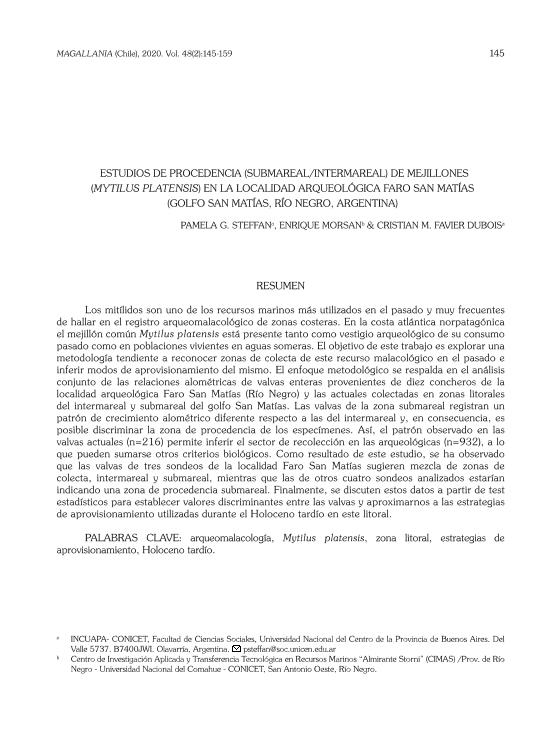Artículo
Los mitílidos son uno de los recursos marinos más utilizados en el pasado y muy frecuentesde hallar en el registro arqueomalacológico de zonas costeras. En la costa atlántica norpatagónicael mejillón común Mytilus platensis está presente tanto como vestigio arqueológico de su consumopasado como en poblaciones vivientes en aguas someras. El objetivo de este trabajo es explorar una metodología tendiente a reconocer zonas de colecta de este recurso malacológico en el pasado e inferir modos de aprovisionamiento del mismo. El enfoque metodológico se respalda en el análisis conjunto de las relaciones alométricas de valvas enteras provenientes de diez concheros de la localidad arqueológica Faro San Matías (Río Negro) y las actuales colectadas en zonas litorales del intermareal y submareal del golfo San Matías. Las valvas de la zona submareal registran un patrón de crecimiento alométrico diferente respecto a las del intermareal y, en consecuencia, es posible discriminar la zona de procedencia de los especímenes. Así, el patrón observado en las valvas actuales (n=216) permite inferir el sector de recolección en las arqueológicas (n=932), a lo que pueden sumarse otros criterios biológicos. Como resultado de este estudio, se ha observado que las valvas de tres sondeos de la localidad Faro San Matías sugieren mezcla de zonas de colecta, intermareal y submareal, mientras que las de otros cuatro sondeos analizados estarían indicando una zona de procedencia submareal. Finalmente, se discuten estos datos a partir de test estadísticos para establecer valores discriminantes entre las valvas y aproximarnos a las estrategias de aprovisionamiento utilizadas durante el Holoceno tardío en este litoral. Mussels are one of the most used marine resources in the past and very frequent in the archaeomalacological record of coastal areas. On the North Patagonian Atlantic coast, the common mussel, Mytilus platensis, is recorded both as an archaeological evidence of its past consumption and as living populations in shallow waters. The objective of this work is to explore a methodology to recognize harvesting areas of this malacological resource in the past and infer modes of exploitation. The methodological approach is supported by the analysis of the allometric relationships of whole valves from ten shell-middens from the archaeological locality Faro San Matías (Río Negro) in comparison with those collected currently in intertidal and subtidal littoral zones of the San Matías Gulf. Shells of the subtidal zone present a different allometric growth pattern with respect to the intertidal ones and, consequently, it is possible to discriminate the zone of provenance of the specimens. Thus, the pattern observed in the current valves (n=216) allows us to infer the collection sector in the archaeological ones (n=932), to which other biological criteria can be added. As a result of this study, it has been observed that the valves of three shell-middens of the locality Faro San Matías suggest mixing of collection areas, intertidal and subtidal, while those of another four shell-middens would indicate a subtidal provenance. Finally, these data are discussed with statistical tests to establish discriminant values among the valves and to approach the procurement strategies used during the Late Holocene in this coast.
Estudios de procedencia (submareal/intermareal) de mejillones (Mytilus platensis) en la localidad arqueológica Faro San Matías (Golfo San Matías, Río Negro, Argentina)
Título:
Provenance studies (subtidal / intertidal) of mussels (Mytilus platensis) in Faro San Matías archaeological locality (San Matías Gulf, Río Negro, Argentina)
Fecha de publicación:
12/2020
Editorial:
Universidad de Magallanes. Instituto de la Patagonia
Revista:
Magallania
ISSN:
0718-2244
Idioma:
Español
Tipo de recurso:
Artículo publicado
Clasificación temática:
Resumen
Archivos asociados
Licencia
Identificadores
Colecciones
Articulos(CIMAS)
Articulos de CENTRO DE INVESTIGACION APLICADA Y TRANSFERENCIA TECNOLOGICA EN RECURSOS MARINOS "ALMIRANTE STORNI"
Articulos de CENTRO DE INVESTIGACION APLICADA Y TRANSFERENCIA TECNOLOGICA EN RECURSOS MARINOS "ALMIRANTE STORNI"
Articulos(INCUAPA)
Articulos de INVESTIGACIONES ARQUEOLOGICAS Y PALEONTOLOGICAS DEL CUATERNARIO PAMPEANO
Articulos de INVESTIGACIONES ARQUEOLOGICAS Y PALEONTOLOGICAS DEL CUATERNARIO PAMPEANO
Citación
Steffan, Pamela Guillermina; Morsan, Enrique Mario; Favier Dubois, Cristian Mario; Estudios de procedencia (submareal/intermareal) de mejillones (Mytilus platensis) en la localidad arqueológica Faro San Matías (Golfo San Matías, Río Negro, Argentina); Universidad de Magallanes. Instituto de la Patagonia; Magallania; 48; 2; 12-2020; 145-159
Compartir




